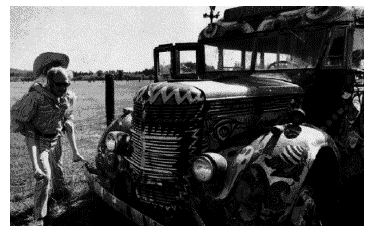I Fall
Peter Coyote
(Counterpoint)

Where were you in the Sixties? If you can remember, you probably weren't there, goes the saying. Peter Coyote was there, helped make it happen, and most impressive, even remembered.
Those who know Coyote only as an actor will have to wait for a sequel to Sleeping Where I Fall to read about his Hollywood years. This is the story of the inception of the Diggers, the San Francisco Mime Troupe and the California Arts Council back in those heady days when we believed we could change the world.
The book is as much a history of the period as it is of Peter Coyote. The artists and the crooks, the visionaries and the politicians who stirred the stew that made the Sixties, walk and stumble and dance through it. Brautigan, Snyder, the Black Panthers, Luis Valdez, Chogyam Trungpa, Jerry Brown, Allen Ginsberg, The Hell's Angels, Stanley Mouse, The Grateful Dead, Janis, Altamont, the Haight, Lenore Kandel, Huey Newton --- here they are again. Forget the "lazy hippie" cliché. These folks were busting their butts for drugs or fame or a better world, or maybe just a place to sack out or a bite to eat.
For all their differences, the forces that added up to the Sixties shared a distaste for the prevailing culture. The irony that only the comfortable have the luxury of such introspection does not negate the thrilling energy of the time and the powerful civil rights, ecology, feminist and anti-war movements whose seeds were planted then and whose results changed us all. The issues of individual and society, anarchy and law, are the subtext here.
The Sixties have been the subject for extravagant praise and extravagant blame. The best summation I've heard came from a young woman born and raised at the Red Rock Commune in Southern Colorado.
- It's been an evolution more than a revolution. In the end, we all go back to the cities and bring our kooky upbringing with us and affect the mainstream or become affected by it. People have been deciding to live different from the mainstream throughout history.
 Sometimes vain, sometimes silly, incredibly naive and vastly experienced, Coyote's knack for administration and true heart carried him through a period that destroyed many of his friends. Those of you, more numerous in Europe than the U.S., who follow Coyote's acting career and perceive a certain depth in his roles will discover the source. Or you may find Sleeping an intriguing history of an important period. It is the answer to the rhetorical questions he asks in the foreword: What do you do when the culture itself is the enemy?
Sometimes vain, sometimes silly, incredibly naive and vastly experienced, Coyote's knack for administration and true heart carried him through a period that destroyed many of his friends. Those of you, more numerous in Europe than the U.S., who follow Coyote's acting career and perceive a certain depth in his roles will discover the source. Or you may find Sleeping an intriguing history of an important period. It is the answer to the rhetorical questions he asks in the foreword: What do you do when the culture itself is the enemy?
Vision:
A Guide to
Visual Awareness
Dennis Roth
(Intaglio Press)
-
some trees are so provocative that one must forcefully dismiss them with 'you brazen hussy'...lest they overpower you with their beauty.
So drop that copy of Vox, you pervert, and prepare for the delights of visual sex, or whatever you want to call the delightful change in perception brought by even a cursory reading of this book. Lust for light!
Otowi Bridge:
The Story of
Edith Warner
and Los Alamos
Peggy Pond Church
(University of New Mexico Press)
What is remarkable about Edith Warner are the friendships she forged with her neighbors, the San Ildefonso Indians and later, in the l940's, with the nuclear physicists who came to work on the atomic bomb at the nearby top-secret Los Alamos Labs. Generations of her Pueblo neighbors gossiped over coffee and cake with the prim, reticent Easterner, as well as the likes of Robert Oppenheimer and Neils Bohr. She lived in the middle of nowhere, on the edge of two vastly different cultures.
This biography, by her friend Peggy Church, tells how Warner's small life led to great understanding. Quotes from the journal pages she left behind reveal a woman living very close to the center of being, possessed of an enviable wisdom and calm. Like her San Ildefonso neighbors, she became one with her place.
This is the twelfth paperbound printing of the small, good-looking book. Though rather incomplete as a biography, it scores as a well-told memoir and as a lesson in the value of trust.
James Roberto Curtis
(Arte Publico Press)
the Wild
Edited by Lucy McCauley
(Travelers' Tales)
 Eaten alive by a wild beast, struck by lightning, drifting in shark-infested waters --- adventures hairy enough to make your asshole pucker are included in this collection of travel essays. There are also some "inner adventures" that are sorta New Agey. Most of the selections deliver that delicious empathetic thrill that's the reward offered by the best travel writing. A couple of pieces, not the most exciting, stand out just because of their beautiful prose.
Eaten alive by a wild beast, struck by lightning, drifting in shark-infested waters --- adventures hairy enough to make your asshole pucker are included in this collection of travel essays. There are also some "inner adventures" that are sorta New Agey. Most of the selections deliver that delicious empathetic thrill that's the reward offered by the best travel writing. A couple of pieces, not the most exciting, stand out just because of their beautiful prose.A line I keep remembering came from a Tohono O'odham elder talking about death, quoted by Alison Hawthorne Dempsey: "It's a place in the desert, right over there."
Over 30 travelers' tales fill this book, and there's not a funny one in the bunch. Writing about nature has always been more about ecstacy than humor. All the contributors are women, but the best writing and the most exciting adventures are genderless.
Well-known contributors include Annie Dillard, Jane Goodall, Alice Walker and Louise Erdrich. The slightly odd cover photo of a woman under either a waterfall or a firehose is redeemed by a good-looking format, with the occasional sidebar and paragraphs by different authors on the same subject following each story.
I usually prefer longer works, but these pieces seemed just the right length. After all, I only wanted to hear these travelers' tales, not have this odd, crotchety bunch move in with me.
--- Cese McGowan